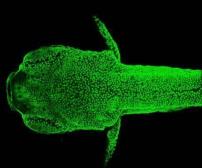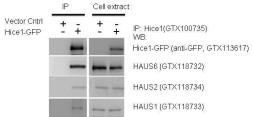InvivoGen带您读文献-自噬与天然免疫
自噬与其作用
自噬(Autophagy)是细胞捕获废物,去除废物和废物循环的三大主要机制之一,另外两种分别是蛋白酶降解(proteasomal degradation)和吞噬(phagocytosis)。在自噬过程中,胞浆中的小分子被新形成的自噬体包住,随后在一种特殊的溶酶体中消化,代谢产物将重新被释放到胞浆中。
自噬,常常被称作巨噬,可将胞浆大块物质转化成营养物质,保障细胞在饥饿,应激等状态下维持大分子合成以及能量平衡。
此外,细胞利用自噬调节特殊的信号蛋白活性,阻止损伤细胞器或长寿、聚集倾向蛋白的积累;去除细胞内病原的威胁。因此,自噬已成为天然免疫的重要部分。
InvivoGen 提供自噬研究相关产品
自噬诱导剂:Metformin,Rapamycin,MG-132, SAHA等
自噬抑制剂:SP600125,U0126,Bafilomycin A1,SB202190等
自噬相关调控基因:ATG,LC3,BECN1,RAB7,TFEB等
自噬体相关细胞:HeLa-Difluo™ hLC3 Cells,RAW-Difluo™ mLC3 Cells

HeLa-DiFluoTM cells were treated with 25 μM rapamycin alone or with 25 μM rapamycin and 500 nM bafilomycin A1 (to inhibit autophagosome/lysosome fusion). After 24 hour incubation, the cells were fixed with 2% PFA and analyzed by confocal microscopy. Note that both yellow (autophagosome) and red (autolysosome) puncta increase in panel viii, whereas most puncta in panel ix are yellow (autophagosome).
自噬信号通路
经典的自噬信号通路通过一系列特定的步骤进行。


自噬从分离膜的成核开始,逐渐将要清除的包浆物质包围成一个口袋。口袋的膜封闭后可形成一个双膜结构小泡,被称为自噬体(autophagosome),随后其外膜与溶酶体融合形成自噬溶酶体(autolysosome)。重新整合的内膜将捕获的胞内物质暴露于溶酶体水解酶,后者将材料分解成代谢产物组分[1,2]。
经典的自噬通路需要一些列进化保守基因的协调动作。小泡成核依赖于由Beclin–1,Vps34和其它蛋白形成的III型磷脂酰肌醇-3羟基激酶(PI(3)K)复合体。
Atg7参与两条泛素化样结合通路:Atg5与Atg12结合,将LC3转化成磷脂酰乙醇胺(PE)结合LC3-II形态。Atg5-Atg12与Atg15L1蛋白形成一个大复合体。两个结合系统都是形成自噬体的必要条件。
然而,我们需要记住这些或其它自噬蛋白也可执行许多非自噬功能。因此,研究者最大的挑战是从自噬蛋白的信号中区分出“真正”的自噬信号。
选择性自噬
在细胞饥饿或某些应激状态下,细胞利用自噬消化和循环胞浆内大的,非特异性组分。然而,自噬也参与免疫信号通路的时空调节(例如,被循环活化蛋白限制细胞因子的产生),以及阻断炎症反应(例如,在损伤的线粒体释放活性氧族(ROS)之前将其去除)。
为了分离和去除特异性威胁,细胞利用选择性自噬结构,在这其中,被选中的靶物质必须首先被泛素标记。泛素化的物质通过LC3被拖入并与分离膜绑定,在众多捕获小体样蛋白(SLRs)中(如p62, optineurin,parkin或PINK1),根据捕获物质的不同,由其中一种蛋白参与捕获过程。
自噬与天然免疫
自噬与天然免疫信号通路有广泛的联系-例如,损伤相关分子模式(DAMPs)和病原相关分子模式(PAMPs)的细胞反应。研究表明,自噬与多种模式识别受体(PRRs)是调节与被调节的关系,这些受体包括Toll-like receptors (TLRs),Nod-like receptors (NLRs),RIG-I-like receptors (RLRs), cytosolic DNA sensors (CDS) 和 Stimulator of Interferon Genes (STING) 以及炎症小体。

这种协作包括正向和负向调节机制,以确保阻止急性炎症反应的产生过度炎症。有趣的是,自噬与其信号蛋白与炎症紊乱(如克罗恩氏综合症),一些癌症和自身免疫病(如硬化症和系统性红斑狼疮)有关[3]。另外,自噬缺陷与神经疾病有关,例如帕金森病症是由蛋白结晶累积造成。
自噬和TLRs
TLRs由细胞膜(TLR1, TLR2,TLR4,TLR5 和 TLR6) 和小胞体 (TLR3, TLR7, TLR8, TLR9 和 TLR13)受体组成,每个TLR都可对自身,病原或肿瘤的同源DAMPs和PAMPs做出应答。代表性的TLR配体包括脂多糖(LPS: TLR4),鞭毛蛋白(TLR5)和 肽葡聚糖(TLR2)等细菌复合物;DNA(TLR9)和RNA(TLR3,TLR7,TLR8和TLR13)等核酸。活化TLRs可诱导产生促炎性细胞因子,在某些情况下,则诱导产生1型干扰素(IFNs)。
TLR诱导的自噬依赖于适配体蛋白MyD88和TRIF;两条信号通路均与Beclin-1直接作用[6]。在巨噬细胞等免疫细胞中,TLR配体刺激诱导吞噬体和自溶酶体的形成[7],并且,在细菌和病毒感染小鼠模型过程中,体内实验(in vivo)证明TLR诱导自噬形成[8]。
自噬调节系统可将DNA和RNA投放到含TLRs的小胞体中。事实上,有报道证明在树突细胞中,自噬和与之密切相关的过程(LC3相关吞噬作用(LAP))在TLR7和TLR9识别核酸过程起到重要作用[7]。
有趣的是,TLR诱导的自噬与一些疾病密切相关。例如,TLR3和TLR4诱导的自噬与肺癌细胞的转移和入侵有关[9]。
自噬与NODs
有报道指出其它天然免疫受体与自噬相呼应,不过有可能是细胞类别特异性现象[10,11]。这些受体包括细胞浆受体,如核苷酸结合寡聚结构域蛋白1和2(NOD1 和 NOD2),后者可分别识别肽聚糖衍生物D-glutamyl-meso-diaminopimelic acid (iE-DAP)和胞壁酰二肽(MDP)。在巨噬细胞中,NOD1和NOD2与Atg16L1协作,诱导自噬;在树突细胞中,细菌配体活化NOD2可导致生成吞噬体[7]。
自噬和cGAS/STING 通路
cGAS/STING 通路是天然免疫细胞浆中识别内源和外源DNA的主要通路。cGAS感受器识别dsDNA(和DNA/RNA混合体),而后产生信使分子2’,3’-cGAMP,一种可活化适配蛋白STING的环二核苷酸,而后,STING驱动1型干扰素和促炎性因子的产生。入侵的微生物也可通过释放的环二核苷酸(CDNs)直接活化STING。
cGAS/STING通路与自噬息息相关。例如,在结合分歧杆菌(M. tuberculosis)感染后,cGAS/STING可激活自噬和1型干扰素产生[7],并且参与此病原的选择性自噬(Selective autophagy)[12]。
有趣的是,有报道证明,cGAS识别胞浆DNA后,可由p62依赖的选择性自噬降解[13]。另外,在M. bovis感染过程中,胞浆DNA感受器AIM2可抑制STING诱导的自噬[14]。
有些报道指出,在某些情况下,cGAS和STING分别与自噬蛋白互动,而这些相互之间的影响并没有被完全解析。例如,cGAS与Beclin-1的相互作用可终止2’,3’-cGAMP的产生[15],因此阻止STING的活化和1型干扰素的过表达。此外,STING的转运似乎牵扯Atg9a[16]。
自噬与RLR
天然免疫的兵工厂中,还有一样武器叫RIG-I样受体 (RLRs),可识别胞浆中自身或外源RNA,包括病毒RNA。主要的RLRs是RIG-I,识别短双链RNA;和MDA5,识别长双链RNA。活化后,这两个受体都要通过激活适配蛋白MAVS诱导产生1型干扰素和促炎性因子。
虽然RLRs与自噬相互影响的报道很少,但是有迹象表明,在细胞质中,自噬负向调节RLRs应答内源或外源RNA,从而限制1型干扰素的产生。例如,自噬蛋白Atg5和Atg12的结合可干扰双链RNA感受器(MDA5 或 RIG-I)和适配器蛋白MAVS的信号传递[17]。与之相似的是,泛素特异性蛋白酶19(USP19)(被证明可正向调节自噬),可通过Beclin-1依赖的方式抑制RIG-I和MAVS的相互作用,从而削弱干扰素信号通路[17]。
自噬,炎症小体和线粒体
炎症小体是一个复合体,由一个天然免疫感受器(AIM2,NLRP1,NLRP3或NLRC4)加上一个适配蛋白,凋亡相关斑点样蛋白CARD(ASC),和pro-Caspase1。每个炎症小体根据其装配的感受器命名。
炎症小体对DAMPs和PAMPs比如胞浆DNA(AIM2),MDP(NLRP1),尿酸(NLRP3)和鞭毛蛋白(NLRC4)作出应答,从而促使促炎性反应。活化炎症小体诱导炎性白介素1和18的前体产生。
研究证实,自噬可调节活化的炎症小体,从而限制过度炎症反应。自噬可通过消化炎症小体介导的白介素前体(如,pro-IL-1)和循环的炎症小体组分(如,NLRP3,AIM2和ASC)来直接限制炎症小体通路[18]。
另外,自噬可通过间接的方式阻止炎症小体活化,前者降解损伤的线粒体,从而阻止炎症小体活化配体-线粒体DNA(mtDNA)和活性氧族(ROS)的释放。最近研究指出,在受损的线粒体膜上,活化的MAVS可直接与LC3相互作用,诱导产生自噬体,从而去除有害细胞器[19]。因此,细胞缺失自噬蛋白Atg5呈现受损细胞器堆积现象,结果导致1型干扰素加剧产生[20]。
结论
2016年诺贝尔生理或医学奖,颁发给发现自噬机制的大隅良典,以表示对这一细胞代谢过程在健康和疾病上至关重要作用的极大肯定。
然而,自噬与天然免疫信号通路相互作用的研究,才刚刚开始。
参考文献
1. Levine B. & Kroemer G., 2008. Autophagy in the pathogenesis of disease. Cell. 132(1):27-42.
2. Mizushima N. et al., 2008. Autophagy fights disease through cellular self-digestion. Nature. 451(7182):1069-75.
3. Netea-Maier et al., 2016, Modulation of inflammation by autophagy: Consequences for human disease. Autophagy. 12(2): 245–260.
4. Xu Y. et al., 2007. Toll-like receptor 4 is a sensor for autophagy associated with innate immunity. Immunity. 27(1):135-44.
5. Delgado MA. et al., 2008. Toll-like receptors control autophagy. EMBO J. 27(7):1110-21.
6. Shi CS. & Kehrl JH., 2008. MyD88 and Trif target Beclin 1 to trigger autophagy in macrophages. J Biol Chem. 283(48):33175-33182.
7. Shibutani et al., 2015. Autophagy and autophagy-related proteins in the immune system. Nat Immunol. 16(10):1014:1024.
8. Zhan et al., 2014, Autophagy facilitates TLR4- and TLR3-triggered migration and invasion of lung cancer cells through the promotion of TRAF6 ubiquitination. Autophagy. 10(2):257-68.
9. Zhan et al., 2014. Autophagy facilitates TLR4- and TLR3-triggered migration and invasion of lung cancer cells through the promotion of TRAF6 ubiquitination. Autophagy. 10(2):257-268.
10. Kroemer G. et al., 2010. Autophagy and the integrated stress response. Mol Cell. 40:280–293.
11. Deretic V., 2012. Autophagy as an innate immunity paradigm: expanding the scope and repertoire of pattern recognition receptors. Curr. Opin. Immunol. 24(1):21-31.
12. Watson et al., 2015. The Cytosolic Sensor cGAS Detects Mycobacterium tuberculosis DNA to Induce Type I Interferons and Activate Autophagy. Cell Host & Microbe. 17:1-9.
13. Chen et al., 2016. TRIM14 Inhibits cGAS Degradation Mediated by Selective Autophagy Receptor p62 to Promote Innate Immune Responses. Mol Cell. 64:1-15.
14. Liu et al., 2016. AIM2 inhibits autophagy and IFN-β production during M. bovis infection. Oncotarget. 7(30):46972-46987.
15. Liang et al., 2014. Crosstalk between the cGAS DNA Sensor and Beclin-1 Autophagy Protein Shapes Innate Antimicrobial Immune Responses. Cell Host & Microbe. 15:228-238.
16. Saitoh et al., 2009. Atg9a controls dsDNA-driven dynamic translocation of STING and the innate immune response. PNAS. 106(49):20842–20846.
17. Jin et al., 2016. USP19 modulates autophagy and antiviral immune responses by deubiquitinating Beclin-1. EMBO J. 35(8): 866–880.
18. Harris et al., 2017. Autophagy and Inflammasomes. Mol Immunol. In press: http://dx.doi.org/10.1016/j.molimm.2017.02.013
19. Sun et al., 2016. MAVS maintains mitochondrial homeostasis via autophagy. Cell Disc. 2:16024.
20. Chan & Gack, 2015. RIG-I-like receptor regulation in virus infection and immunity. Curr. Opin. Virol. 12:7-14.
订阅金畔微信公众号,随时掌握第一手新消息,促销 产品试用 奖学金 都信手拈来,还不快扫一扫我们的公众号,或直接搜索关注“上海金畔生物”,更多惊喜等你发现!
上海金畔生物科技有限公司







